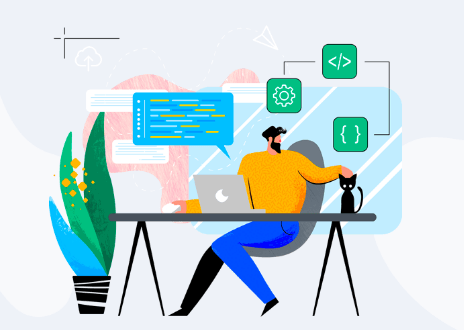The web is constantly evolving with new technologies. Thanks to technology experts and professionals who work tirelessly to offer uniqueness and newness to the consumer base. Finally, we reached the data web. Yes, we’re talking about big data and how it’s changing everything around us.
The past decade has seen the explosive growth of web publishing and the emergence of two critical technological fields: Web Design and Data Science.
Data science, web design, and development use digital tools and technologies to create specific products or experiences. Data science focuses on prediction and research, while the best website development company aims to improve user experience. In this article, we will discuss how the intersection of Web Design and Data Science will shape the future of technology.
Data Science vs. Web Design & Development :
Before we go into the numerous ways that learning data science can help you improve your web design and development career, we must understand the differences and similarities between the two. Both inside and outside the science and technology industries, data science and web design and development are concerned with using digital tools and technologies to create a specific product or experience. While Data Scientists collect and analyze data to make predictions and conduct research, Web Designers and Developers primarily use data to improve the design of websites and the consumer experience.
Both industries rely on specific types of data, programs, and algorithms to improve or better understand the conditions of a particular industry or technology. While Data Scientists apply their knowledge broadly by conducting assessments across industries, Web Designers and Developers specialize in using data to improve websites, applications, and other digital media platforms. In this sense, Data Scientists use data for research, whereas Web Designers and Developers use it for user experience. As a result, both professions work toward specific goals and objectives set by an individual or institution that needs a particular product or set of services.
How will the intersection of Web Design & Data Science lead the future of technology?
Below is the list of following ways to discuss the intersection of Web Design & Data Science to lead the future of technology:

1. Customizing for end users:
We have previously discussed how data science can be used to customize web development for clients, but the ultimate goal should be user satisfaction. Satisfaction is a personalization-dependent variable. To create a personalized product for users, web developers must first understand them; Data science online course can help.
Spending habits, preferred websites, interest areas, age, geographical location, gender, and other end-user data are used to build algorithmic models that predict the consumer’s compatibility with your web applications. Using these models, you can provide a personalized user experience on your website and strategically place ads targeting specific customer segments, resulting in a win-win situation for both buyer and seller.
2. Faster Development Process:
Using advanced analytical tools enables you to analyze massive amounts of data. These tools make precise recommendations regarding web functions and features. Understand and learn what users prefer. To speed up development, integrate data ingestion tools that efficiently collect and organize data from multiple sources in real time, providing clear insights to guide your decisions. This will expedite the entire web development process. You’ll have clear indicators of what needs to be done rather than relying on guesswork or creativity to achieve the best results.
The needs of users are constantly changing. Data science and web design services Milwaukee help you meet those demands on time. Having accurate information allows for faster and easier web design and development.
3. Changing Hot Skills:
Aside from changing the way developers design the web, data science is also impacting the evolution of web development in another way: it is revolutionizing the job market. With the industry’s ever-changing needs, a custom web development company wants employees proficient in using cutting-edge data analytics tools.
Developers looking for jobs today are expected to know tools like Python and Google Analytics. They are asked about their experience developing AI and machine learning programs in interviews. To remain relevant, one must stay up to date.

4. Customers’ Expectations:
Do you get frustrated when an Uber driver calls you to ask about your pick-up location when it is easily tracked by GPS and displayed on his device’s screen?
Won’t you be uncomfortable if you misspell something while typing on your messenger and autocorrect stops working? And doesn’t it feel nice when you buy a phone online, and the web app recommends the latest phone covers?
Customers around the world appreciate the extra assistance provided by businesses. Because of this reliance on data, data science will soon become a must-have in web development.
5. Heat Map Analysis:
Monitoring site areas with the most user interaction will help you make the necessary design updates, improve the overall user experience, and drive more traffic to your online platform. Data science enables heat map analysis. This will allow you to take the appropriate measurements and determine which aspects capture the user’s attention and which have a negative impact.
6. Automatic Updates:
Gone are the days when updates had to be manually administered by the developers. Machine learning enabled tools to analyze consumer behavior and data available on social media platforms, resulting in necessary updates. Websites are self-learning so that they can adapt to changing customer demands. It is only possible because data science is doing its job perfectly.
Although creating customized solutions for various clients remains challenging, custom web development services will soon make it more accessible thanks to data science.
Conclusion:
As we’ve seen, data science and web design are two separate but increasingly interconnected disciplines. To summarize, data science focuses on extracting insights from data using statistical and computational techniques, whereas web development focuses on creating websites and web applications.
Many organizations seek data scientists who communicate insights via web dashboards and visualizations. At the same time, web developers are increasingly incorporating data analytics into their platforms and applications.










Leave a Comment
Your email address will not be published. Required fields are marked *